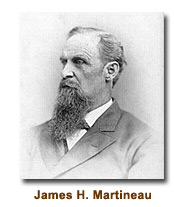From the Book “Pioneer Photographers of the Far West”
written by Peter E. Palmquist and Thomas R. Kailbourn
James Henry Martineau (1828-1921) photographer, surveyor, active Utah (Salt Lake City) 1863; Logan, Utah, 1866-c. 1869.
James Henry Martineau was born on March 13, 1828 in either Port Jackson or Amsterdam, Montgomery County, New York. His father, John Martineau, was a civil engineer and a descendant of Elie and Marguerite Maratineau, French Huguenots who fled to the New World in 1682. His mother Eliza Mears Martineau was of English Puritan descent. As a young man, James H. Martineau worked as a pressman for several newspapers in New York and Wisconsin. During the Mexican War he enlisted in the regular army but served out his hitch as a drill sergeant and clerk at Newport Barraks, Kentucky. In 1849 he began to work his way westward to California, but upon reaching Utah Territory the following year, he decided to settle in Farmington. Martineau was baptized a Mormon in January 1851.
Two months after his induction into the church, Martineau moved to Paraowan, Utah where he lived for nine years. He was the first clerk of Iron County, and served terms as county surveyor and sheriff, city recorder of Parowan and adjutant of the Iron Military District, which included the southern half of Utah Territory.
On January 8, 1852, Martineau married Miss Susan Ellen Johnson (1836-1919) Two years later he was a co-founder of the Parowan Dramatic Assosciation. He painted the scenery for the group’s performances, played bass violin in the orchestra, and led the choir. Martineau contracted a plural marriage with Susan Julia Sherman (1838-1874) in Salt Lake City on January 18, 1857. In July 1860, at the behest of Brigham Young, Martineau moved to Logan, Utah to survey the Cache Valley. Over the next few years he was surveyor and clerk, city recorder for Logan, and a U.S. Deputy internal Revenue Collector. Despite all these duties, he also found time for farming.
In July, 1863 Martineau learned the photographic business from Edward Covington, although uncertain if this occurred in Logan or Salt Lake City. Martineau evidently adopted this trade as a supplemental source of income. He probably did not get to practice the profession soon, because by September he was surveying the communities of Stockton and Oxford in Idaho Territory. In 1866, Martineau established a gallery in Logan, using equipment he purchased from an unidentified local photographer who was leaving the business. In July 1867 he paid a $6.67 federal tax assessment on the gallery. Throughout this period of photographic work, Martineau also continued his surveying duties. However, in a memoir Martineau published in 18898, he recalled that from the fall of 1869 through 1870 he was “mostly at home, photographing.” Toward this end he renewed the liscense for his gallery in October 1869 for $5.83. Ultimately he sold his photographic business to Davy Lewis, a British immigrant not to be confused with photographer David Lewis.
After leaving the photographic profession, Martineau continued his distinguished career as a surveyor. He helped locate and survey the Union Pacific Railroad route from Echo Canyon, Utah Territory to Central, Nevada Territory, in 1868 and from Ogden to Salt Lake City in 1869. He was chief Engineer of the Utah Northern Railroad in 1871-72. In the early 1880’s he surveyed in Arizona, and during his years in that territory, and Utah he laid out thirty five towns. In 1888 he moved to the Mormon enclave of Colonia Juarez in the state of Chihuahua, Mexico. Martineau and his wife Susan left their children, now grown, in Chihuahua and moved back to Logan, Utah, in 1908. They lost all of their Mexican property in the Revolution. James H. Martineau died in Salt Lake City on June 24, 1921, at the age of ninety-three.
From the Book “Pioneer Photographers of the Far West”
written by Peter E. Palmquist and Thomas R. Kailbourn
Subscribe to:
Post Comments (Atom)



No comments:
Post a Comment